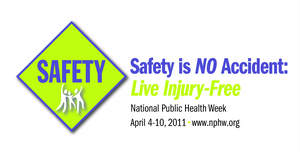MISSION, KS--(Marketwire - April 4, 2011) - (Family Features) Did you know that preventable injuries rank among the top 10 causes of death for people of all ages? While it's not something that many people often think about, the American Public Health Association (APHA) helps to bring injury and violence prevention messages through this year's National Public Health Week (NPHW) and warns that everyone is at some risk of injury, even at home.
Home Injury Facts
- Four out of five U.S. fire deaths in 2008 occurred in the home.
- Every day in the United States, about 82 people die as a result of unintentional poisoning, and another 2,000 are treated in emergency departments.
- Falls are the leading cause of injury death among those aged 65 and older. More than one-third of U.S. adults 65 years of age and older fall each year.
- Falls are the leading cause of Traumatic Brain Injury (TBI) in the United States. Falls cause half of the TBIs among children aged 0 to 14 years and 61 percent of TBIs among adults aged 65 years and older.
A survey by the Home Safety Council (HSC) showed that while nearly 60 percent of American parents feel there are steps they could take to reduce the risk of a home-related injury, a third of them just don't know what actions to take. This checklist from APHA's NPHW will help you make your home safer today.
General Safety Tips
- Assess your home for potential hazards such as poor lighting and uneven surfaces to prevent falls.
- Install and maintain smoke alarms and carbon monoxide detectors in your home.
- Establish a plan for evacuating from your home in the event of a fire.
- Make sure all electrical outlets are covered and inaccessible to children.
- Program emergency numbers, such as the Poison Control Hotline (1-800-222-1222), into your phone to call in the event of a poisoning emergency. Also, make sure they are posted near all land line phones.
- Check your hot water heater to make sure the thermostat is set to 120°F or lower to avoid burns. According to the HSC, nearly 4,000 home injuries occur annually due to scalding. It only takes one second for a child under the age of five to get third-degree burns from water that is 140°F or hotter.
- Install four-sided isolation fencing at least five feet high and equipped with self-latching gates to prevent drownings in home swimming pools.
In the Kitchen
- Supervise young children whenever they're near cooking surfaces and never leave food unattended on the stove. Keep things that can catch fire, such as dishtowels, paper or plastic bags at least three feet away from the cook top.
- While cooking, make sure pot handles are turned inward to prevent the hot pan from being pulled or knocked down.
In the Bathroom
- Store cleaning supplies and medicines in locked cabinets out of the reach of children.
- Make sure child safety caps are on all medications and cleaning products.
- Be cautious of cleaners or medicines with fruit shown on the labels -- small children may think they are okay to drink.
Making just one positive change a day can help prevent injuries and help your family start living a safer life. For more information about injury prevention, visit www.nphw.org.
Contact Information:
Wendy MacDonald
wmacdonald@familyfeatures.com
1-888-824-3337 ext. 235
http://editors.familyfeatures.com
